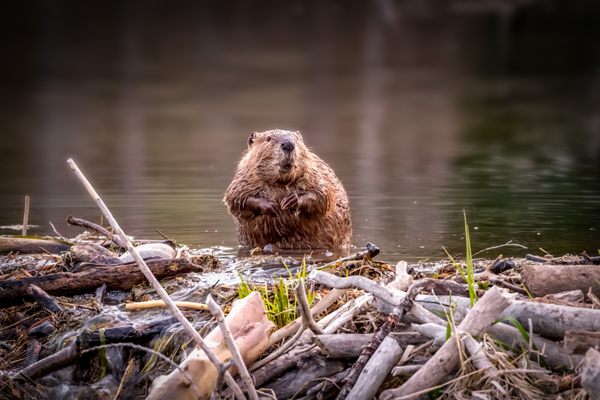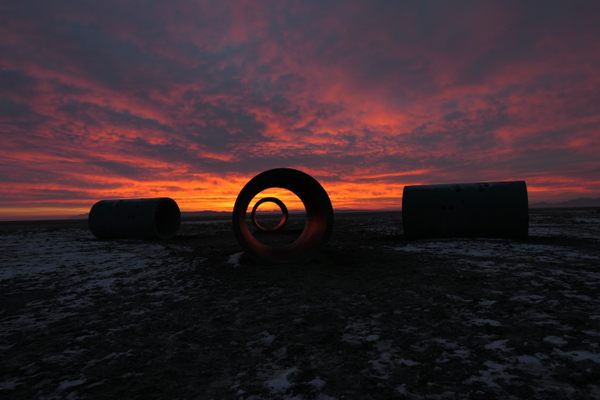Lassen Volcanic National Park Bounces Back After California’s Largest Single Fire
In 2021, the Dixie Fire burned much of the park. Now, Lassen’s recovery offers surprising lessons on resilience.
This piece was originally published in The Guardian and appears here as part of our Climate Desk collaboration.
The fire was coming. Roughly 30 miles of dense forest withering under extreme drought stood between Lassen Volcanic National Park and the Dixie fire—land ready to ignite.
The historic town of Greenville had already been reduced to rubble by the flames. Entire communities had fled. Jim Richardson, the park superintendent, understood the blaze would soon be at his doorstep despite the efforts of thousands of firefighters. The question on his mind was what could be spared in the fire’s march across the Sierra Nevada.
“We knew that all the fuels in the forest around us were very flammable,” Richardson said. “Within the first two days I recognized that our park was at risk from this fire.”
The events of August 2021 are seared into the landscape of Lassen. Hillsides are blackened, trees are charred and toothpick-thin. A drive along the park highway, around meandering mountains and bubbling mud pools, reveals swaths of land reminiscent of Mordor. Fire is a part of the ecosystem here, but the park had never before experienced one as destructive as the Dixie fire.

The blaze, California’s largest ever single fire, burned almost 70 percent of Lassen. A third of the burn area saw the sort of high-severity fire that kills most trees and bakes the nutrients from topsoil.
However, there is evidence of resilience among the devastation: sprouts emerging from the scorched soil and the black and green mosaic of the mountains. The recovering ecosystem in this off-the-beaten path national park serves as a reminder of the threats to the United States’s wild places and offers lessons about how to protect public lands in an era of climate crisis.
Lassen Volcanic National Park, located in far Northern California at the southern end of the Cascades, has been shaped by disaster. It was created after the 1915 eruption of Lassen Peak to preserve the area for future study, becoming only the 17th national park.
In July 2021, it had recently fully reopened after the winter’s below-average snowpack melted. While less popular than Yosemite or Joshua Tree, Lassen typically received over 500,000 annual visitors. The park was anticipating more record visitation amid the Covid-19 pandemic from travelers eager to see the world’s largest volcanic dome, explore trails leading to waterfalls and hydrothermal features, and trek along the Pacific Crest Trail.

But as the Dixie fire burned across the Sierra Nevada, Lassen staff closely monitored the blaze, and soon closed two remote entrances and halted backcountry overnight camping. By early August, Lassen closed completely to give firefighters unimpeded access. Staff often worked 16-hour days mapping out the blaze and figuring out how to protect the park and buildings, Richardson recalled.
Prescribed burns and natural fires had already reduced much of the vegetation in some parts of Lassen. But with the Dixie fire roaring closer, firefighters sought to do more to try to save what they could, including the Kohm Yah-mah-nee visitor center and nearby towns.
Crews spent days using heavy machinery to clear fuels around fire lines, and then, when the wind allowed for it, they set another fire in the path of the oncoming blaze. They laid fire around the visitor center and the park highway that merged with the Dixie and another recently sparked fire. The flames of the Dixie consumed wide swaths of the park, chewing through the backcountry bridges of the Pacific Crest Trail and devouring a nearly century-old fire lookout.
Firefighters managed to achieve their mission. The visitor center was spared, as were the towns of Mill Creek, Mineral and Old Station. The damage to Lassen was extensive and unprecedented—staff are still calculating the total cost of the losses. But years of prescribed burns helped to temper the worst effects of the fire.

Even with the damages, Richardson was struck by what remained. Most of the facilities survived, and in some areas, high-intensity fire had slowed or burned out entirely thanks to prescribed fire projects and manual work to thin out trees, remove dead trees and clear pine needles from buildings.
That work over the last 20 years ultimately helped reduce the severity of the Dixie fire in the park, said Gary Bucciarelli, an ecologist and the director of the University of California, Davis’s Natural Reserves Lassen field station. Fire is a vital part of the ecosystem, he said, and without it, fuel loads build up and the fires that occur are more severe.
“When you’re not letting those natural fires occur, when you’re not letting fire have a role, fires become devastating,” he said. “That’s what we’ve seen, these huge fires that are not the type of fires that normally occurred in these ecosystems.”
From a distance, the trail next to the Kohm Yah-mah-nee visitor center appears to offer a window into all the devastation wrought by the Dixie fire.
The path unfurls itself through blackened forest with singed trees, but as it winds over a bridge and up a hillside, there is a sudden burst of green. The land is verdant and dotted with wildflowers. Grasshoppers emit an electric hum that fills the air.

Many of the burned trees are gone—with help from the Mooretown Rancheria of Maidu Indians of California. The hazards have been removed, though some bridges in the back country await replacement. The park highway offers a glimpse of the area’s natural wonders and a living model of what happens when fire moves through the landscape.
Visitors often remark to Ranger Russell Rhoads how sad it is to see Lassen this way. While high-severity burn areas may take decades to recover, the ecosystem remains viable, he said, and the park has even more prescribed burns planned.
“For a lot of people, all they see is sort of the black and brown,” Rhoads said. “There’s still beauty in between.”
If you look closely, you can see mushrooms and insects that will act as decomposers for dead logs, Rhoads said, and those insects will eventually serve as food to birds and other animals.
Even the rotting tree stumps will have larger grubs that the bears can eat, Rhoads added. There are opportunities for new plant growth within the burn areas and the diminished tree canopy allows for the growth of shrubs and grasses that will feed other animals. Birds of prey can more easily navigate the forest.
In the presentations on the Dixie fire that he gives at the visitor center, Rhoads tries to remind people that fire is a part of this land. Some trees only spread their seed during fires.
“People say: ‘I’ve never seen it like this my entire lifetime that I lived here.’ In my lifetime, it’s all I see,” he said. “Fire was suppressed during your entire lifetime, the fuels accumulated and now it’s just unmanageable.”
But Rhoads is optimistic about the future. Nature is characterized by change, he said. “It’s adaptable. It’s able to just sort of do what it wants it to do.”
The resilience of Lassen is visible across the landscape, he said. At Chaos Jumbles, the site of a massive rockfall 350 years ago, a field of seemingly impenetrable rocks stretches across the land, yet trees somehow make their home there.
“This is obviously not the most hospitable terrain, but it still popped out one way or another,” he said. “That’s just the way this ecosystem is. It gets thrown a hard pass, and then it just recovers and does something different. It doesn’t have to turn back into what it was before.”









































Follow us on Twitter to get the latest on the world's hidden wonders.
Like us on Facebook to get the latest on the world's hidden wonders.
Follow us on Twitter Like us on Facebook